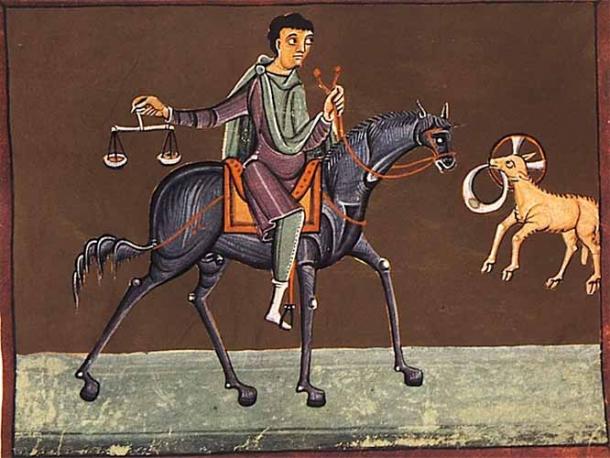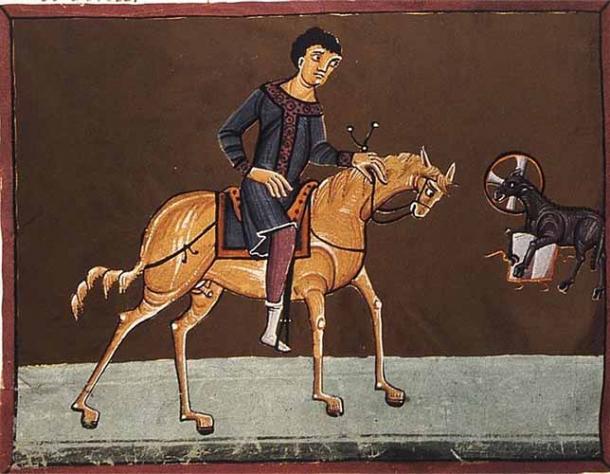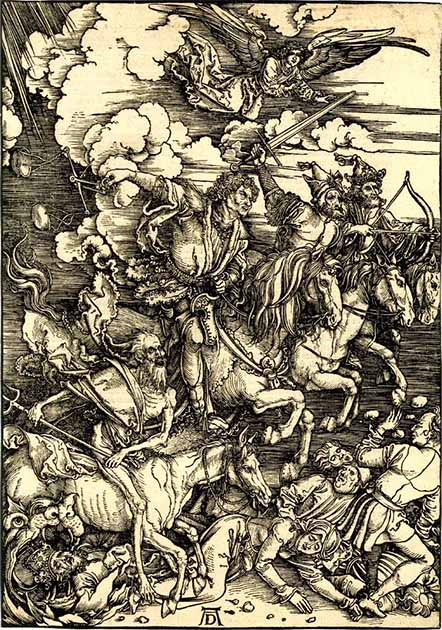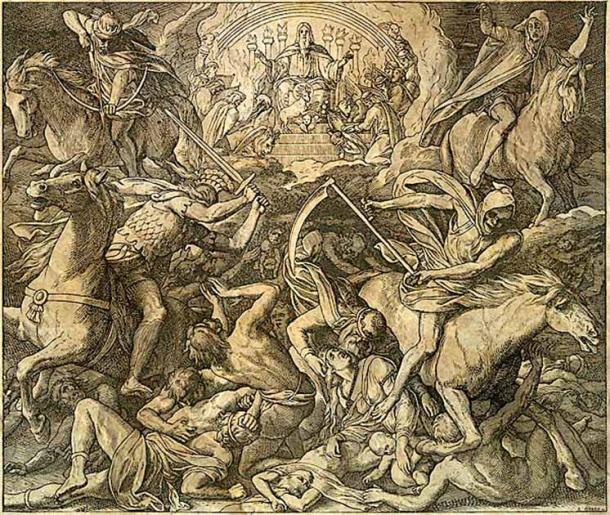
The Four Horsemen of the Apocalypse: Unleashing the End of the World
Throughout the history of civilization, the notion of the apocalypse has been a recurring theme in human history, transcending cultures and religions. It represents the ultimate reckoning, a purification of the world through catastrophic means. Among the most fascinating prophecies of this impending doom are the Four Horsemen of the Apocalypse, as depicted in the Bible’s Book of Revelation.
By understanding the legend and its various interpretations, it’s possible to envision this end of the world prophecy and the crumbling of civilizations at the hands of War, Famine, Pestilence and Disease. On re-examining the Book of Revelation, could it be that we discover any kernel of truth within the religious mythology of the Four Horsemen of the Apocalypse?

“Death on a Pale Horse” by Benjamin West, is a 1796 painting of the Four Horsemen of the Apocalypse. (Public domain)
When Seven Trumpets Shall Sound! Origins of the Four Horsemen of the Apocalypse
The Book of Revelation within the New Testament details a doomsday prophecy as written by John the Theologian of Patmos. Within a chapter recounting the story of a doomsday revelation, the Four Horsemen of the Apocalypse appear to bring about destruction on Earth and decimate its population.
This chapter is commonly interpreted as a period in history where wars, diseases, and hunger would cause a significant portion of the Earth's population to perish. In the Bible, these hardships are described as horsemen, riding in succession at the behest of Jesus, in the form of the Lamb of God. This title comes from the Bible, John 1:29, when John the Baptist exclaims: “Behold the Lamb of God who takes away the sins of the world.”
- How it Ends: The Ancient Roots of Doomsday Prophecies and End of the World Beliefs
- The Story of Ragnarok, The Ancient Norse Apocalypse
The chapter begins by describing a divine scroll, held by God in his right hand and sealed with seven seals. Their opening, and the subsequent apocalypse, would usher the second coming of Jesus. Each one of these seven seals represented a different aspect of the apocalypse.
The first four seals related to the horsemen, the fifth released the martyr’s cries for the God’s wrath. Meanwhile, the sixth ushered in a series of cataclysmic natural disasters and the seventh called forth the seven angelic trumpeters, carrying seven vials of plagues and divine wrath which they would pour out on the sinful and the wicked.
Within the prophecy, the Lamb of God opens the first four seals, and on doing so summons forth, one after another, the Four Horsemen of the Apocalypse, setting in motion the ferocious cleansing of the Earth.

The Lamb opening the book/scroll with seven seals. The first four seals summon the Four Horsemen of the Apocalypse. (Public domain)
The White Horseman of the Apocalypse
“And I saw and behold a white horse: and he that sat on him had a bow; and a crown was given unto him: and he went forth conquering, and to conquer.” – Revelation, 6:2
Throughout history, various sources often explained the first rider in various different ways, since his role is the only one not explicitly stated. While most interpreters agreed that the white rider symbolizes disease and pestilence, it wasn’t always the usual claim. There is a widely attested description that places this white horseman as a metaphor for righteousness.
In a world where sin is rampant, a righteous harbinger of justice and righteousness would seem a fitting purifier in an apocalypse. The crown that was “given unto him” could signify the rule of justice above all, or symbolize a truly just leader, if such a one can exist.
But the symbolism of disease and pestilence could still be the most plausible description. The aspect of a conqueror is cognate with the sweeping of a major plague (the Great Plague is a good example) and the crown would symbolize the ultimate rule of death above all else.
But as the time progressed, and by the time of the beginning of the 16th century, many have come to interpret the white rider as the personification of the Second Coming of Christ, or even Christ himself. At the time of the major crisis and the break of western Christianity with the reforms of Martin Luther, this came as a most logical and accepted explanation.
The white color of the horse and the rider was quickly connected with divine purity and absence of sin, and the bow he carried as the tool of divine punishment. Likewise, the white rider was interpreted as the Holy Spirit – pure and just.
Another popular view is much simpler – the white horseman could just be the personification of mass conquest. The passage, relating to the rider that “went forth conquering, and to conquer” could simply be that – a descent of a prophesied conqueror that will enslave the populace of the Earth.

The first horseman, the White Rider, of the Four Horsemen of the Apocalypse. (Public domain)

The second horseman, the Red Rider, of the Four Horsemen of the Apocalypse. (Public domain)
The Red Horseman of the Apocalypse
“And there went out another horse that was red: and power was given to him that sat thereon to take peace from the Earth, and that they should kill one another: and there was given unto him a great sword.” – Revelation 6:4
The Red Horseman is widely connected with war. The translations often correlate in the descriptions: the horse is “fiery” red, and the rider bears an upright sword in preparation for battle. The red color is thought to symbolize the fire and blood of warfare, and the rider’s ability to make men kill one another clearly symbolizes constant and global warfare.
War as an apocalyptic aspect was always present throughout time and is the most straightforward herald of death. In Matthew, 24:6-7, Christ states: “And ye shall hear of wars and rumors of wars; For nation shall rise against nation, and kingdom against kingdom…” This quote clearly relates to the ever-present aspect of warfare as a symbol of the final revelation.
Another interesting quote could also be adapted to the Red Horseman and warfare as the aspect of evil and the Antichrist:
“From the eternal sea he rises,
creating armies on either shore,
turning man against his brother,
until man exists no more.”
The red horseman could also signify the sin of hatred and aggression as a contributing factor to the prophesized end of the world. And in a paradoxical turn of events, the Lamb of God releases that same aggression to smite the wicked with fire and sword. The prophecy of constant warfare that is supposed to descend on Earth is clearly described with the red rider having divine authority to take peace from the Earth.

The third horseman, the Black Rider, of the Four Horsemen of the Apocalypse. (Public domain)
The Black Horseman of the Apocalypse
“And I beheld, and lo a black horse; and he that sat on him had a pair of balances in his hand. And I heard a voice in the midst of the four beasts say, A measure of wheat for a penny, and three measures of barley for a penny; and see thou hurt not the oil and the wine.” – Revelation 6:5-6
Another easily interpreted figure, the black horseman was almost always universally described as a personification of Famine. The horse’s black color was widely attributed to negative aspects – mourning, carrion ravens, night, desolation, and bleakness – all of which are aspects of famine as well. The rider is said to carry in his hands a pair of balances.
This is the chosen translation of the original word – the Greek zugón – which generally means a “yoke”, as in a burden and a yoke for oxen. Both description carry negative connotations. The yoke is synonymous with servitude and slavery, and the pair of scales signifies the rationing and measuring of food. This was the common ancient practice of ascribing value to things.
The passage states that a single penny (orig. denarius) would be sufficient to acquire only a meager ration of wheat, and even less of barley. This is clearly an ancient view of what a famine would look like, since wheat was a staple of the diet and without it bread was lost.
The final part of the passage states that while the prices of wheat and barley are affected, the ones of oil and wine are not to be changed. This was interpreted in several different ways, and could signify a paradoxical aspect, in which the staple foods are gone, while wine remains – furthering the famine while leaving the luxuries which cannot feed a man.
One popular interpretation states that the black horseman signifies the Imperial, ruling oppression of the lower class. The rich rulers hold the scales and dispense what meager rations they deem sufficient, while the luxuries remain abundant and out of reach for the poor. A growing divide between classes and fellow men could be a perfect aspect of an end time revelation.

The fourth horseman, Death, of the Four Horsemen of the Apocalypse. (Public domain)
The Pale Horseman of the Apocalypse
“And I looked and behold a pale horse: and his name that sat on him was Death, and Hell followed with him. And power was given unto them over the fourth part of the Earth, to kill with sword, and with hunger, and with death, and with the beasts of the Earth.” - Revelation 6:8
The final, fourth horseman serves as a sort of epilogue, a dramatic crescendo that culminates with the most powerful and feared rider – Death itself. In the entire chapter, he is the only rider who was named, and the only one without a weapon – for he himself is a weapon. The rider and the horse are depicted as pallid, bearing the sickly and lifeless color of a corpse, and the ability to extinguish all manner of Earthly life through various natural means.
- Ancient Fears to Keep You Up at Night - The End Really, Really is Nigh
- The Terrifying Doomsday Prophecy of the Tiburtine Sibyl
The pale rider contains elements of all preceding ones and could be termed the most significant of the four. In his wake follows Hell, the final culmination of all things horrific, seemingly ready to swallow all the wicked that will perish in the apocalypse.
The part that states that power was given unto them over the fourth of the Earth could be interpreted in various ways. While it could be that all four riders would wreak havoc over a quarter of the planet, it could also signify that each of the four would have a single quarter of the Earth.
The passage states that the rider would kill with the beasts of the Earth. This could be a hint to the animals and the nature that promptly retake the regions which are depopulated, signifying the ultimate reign of wild nature over the man.

Woodcut by Albrecht Dürer of the Four Horsemen of the Apocalypse. (Public domain)
Death Rides a Pale Horse – Apocalypse in Art
The prophecy of the Four Horsemen of the Apocalypse has long been the subject of inspiration for many artists, who chose that influential and critical subject as the source for monumental artworks. Throughout time, many artists portrayed the Four Horsemen of the Apocalypse in the way they interpreted them, which also provides good insight into the prophecy.
One of the more popular depictions was made in 1887, by the renowned Russian painter Viktor Vasnetsov. His large painting, Воины Апокалипсиса, is a colorful, detailed and contemporary depiction of Death, War, Conquest and Famine. They are given modern attributes and were intended to reflect on the populace of the time.
Some of the earlier, medieval depictions were much more dramatic and almost unsettling, certainly aimed at putting fear into the more doubtful believers. One such depiction was made between 1496 and 1498, by Albrecht Dürer, the renowned artist of the German Renaissance. His dramatic woodcut represented the Four Horsemen of the Apocalypse as elderly, ghastly, and emaciated men, whose equally unsettling stallions are trampling the sinful and gluttonous people below.
A similar woodcut was made between 1851 and 1860, by Julius Schnorr von Carolsfeld, a German painter, who portrayed a savage and merciless massacre of sinners by the four riders, all under the watchful eyes of the Lamb of God.

illustration entitled Throne Room and Four Horsemen of the Apocalypse by Julius Schnorr von Carolsfeld. (Public domain)
Until Man Exists No More
To date, the story of the Four Horsemen of the Apocalypse remains as a stark vision of the paradoxical, inherent nature of man. From its earliest forms it served as a warning for the wicked to change their ways, a plea for temperance and peace, for moderation and humility.
Yet we see that in the 21st century, much that was described in the Book of Revelation and the tale of the Four Horsemen of the Apocalypse has come to pass. From countless famines, to plagues and pestilences, to endless wars and decadence – the apocalypse seems to have occurred several times over. Or is it yet to come?
Top image: Each of the Four Horsemen of the Apocalypse represent different aspects of the cleansing of the Earth, by Russian painter Viktor Vasnetsov. Source: Public domain
References
Cunningham, A., and Grell, O. 2002. The Four Horsemen of the Apocalypse: Religion, War, Famine and Death in Reformation Europe. Cambridge University Press.
Flurry, G., and Turgeon W. 2013. The Four Horsemen of the Apocalypse. Philadelphia Church of God.
King James Bible.
Ritenbaugh, T. 2004. “Four Horsemen of the Apocalypse - Sermons, Bible Studies, Articles, and Essays” in Church of the Great God. Available at: https://www.cgg.org/index.cfm/library/topic/id/2192/four-horsemen-of-apocalypse.htm
















Comments
Almost every war... ALMOST EVERY WAR.. we have a conqueror.. then the dead bring disease... Then the famine.. .. and widespread death as a result.. but... Time will tell... They are attempting it now.. the Obama photo with the 1st horseman symbolism . I pet goat 2.. a final destructive war.. but it will be delayed... The mountain must fall 1st...
infinitesimal waveparticles comprise what we call home the earth
manipulatable by thought ability supressed in humans since birth
The study of Revelations is uniquely interesting. To the most fervent believer it was written by John, Disciple of Jesus. John is the one the Bible says ‘Jesus Loved’. Yet Revelations we are told was written almost 400 years after crucifixion of Jesus on the Island Patmos. For most modern clergy it is difficult to believe that John survived 400 years and was its author so they attribute the book to some other John. This other John they name “John the Revelator”.
If one studies this curious anomaly of age it is not without its own evidence of potential factuality. First we have the testimony of the other disciples.
John 21 22 Jesus answered, “If I want him to remain until I return, what is that to you? You follow Me!” 23Because of this, the rumor spread among the brothers that this disciple would not die. However, Jesus did not say that he would not die, but only, “If I want him to remain until I return, what is that to you?”
The Bible simply suggests that John ‘could’ live until the ‘Return’ IF Jesus wanted that.
What other evidence is there? The Catholic Encyclopedia states that the Romans sought to kill John the Evangelist in a variety of ways. Their last attempt it seems was to boil John in oil yet he came out of the boiling oil unscathed.
The next claim in recorded history that John remained alive was this. It is said that on a journey back from mass on the feast day of St John the Evangelist, King Edward was stopped by a beggar asking for Alms, or money for the poor. The King who had no money on him, took a ring from his finger and gave it to the man.Some time later, two pilgrims in Jerusalem met an old man who asked them to return the ring that he had been given by the king. He told them that in six months, the King would come to live with him. When the pilgrims asked who he was, the man replied ‘St John the Evangelist.’ Supposedly, this happened six months before King Edward died Jan. 5, 1066.
Fact or Fiction this is up to both one’s Faith and their interpretation. Believers have no issue it seems believing the ancients like Methuselah could live 969 years or four men could spend a night in a fiery Furnace, Jesus could raise a dead man, or he could arise from the grave yet they discount that any of this might just be true. In fact most people today put more stock in the Horoscopes in the local paper.
Yet in a day and time when science gives plausible credibility to multiple dimensions, time travel, time warps and numerous other imponderable concepts Biblical Miracles are fully discounted.
As I have studied Revelations for ¾ of a century and in that I happened to be in Germany in 1986 when I believe/suspect/think Revelations 8:10-11 most likely occurred I am not one to discount anything at all in this book of mysteries.
Revelation 8:10–11 — King James Version (KJV 1900)
10 And the third angel sounded, and there fell a great star from heaven, burning as it were a lamp, and it fell upon the third part of the rivers, and upon the fountains of waters; 11 And the name of the star is called Chernobyl* and the third part of the waters became Chernobyl; and many men died of the waters, because they were made bitter.
*Note: Above is a translated ‘EXACT’ quote from a Ukrainian Bible. An English language Bible will translate Chernobyl into the word ‘Wormwood’. One might find it interesting that the Chernobyl disaster occurred in Ukraine and the description of star’s power might be inferred to be a Nuclear Reaction.
As is the case in all things one might read in The Book of Revelations what the ‘Star’ Wormwood/Chernobyl portends is up for each person’s individual interpretation.
At this point in human history with threats of Nuclear War coming from so many nations I find myself picking up the Good Book and re-reading its prophecies repeatedly.
What should have been 'comment' became "century". As I have not been able to edit or delete comments here for a long time, I must leave it as it is.
As I check this century, a pop-up appears about the New Orleans Mardi Gras, to illustrate my last paragraph perfectly. He who does not see this proliferation does not want to see.
There are many prominent devotees of the Antichrist who wish to bring Revelation to fruition, but with a different ending.
These devotees are responsible for much or almost all modern politics, banking, big business, entertainment, healthcare and even much modern Abrahamic religion itself, including non-mainstream ones. They're also behind soft Occultism, Paganism, New Age spiritualism and are active in other faiths.
Politics and religion for the masses, for example, are easily hijacked. It is like an illiterate man wanting to read and write. He goes to a teacher and is told about the vowels, but also that the consonants, punctuation and grammar don't exist.
Unhappy, he consults a different teacher and is shown the consonants, while being told the vowels, punctuation and grammar don't exist.
Maybe the latter is better than the former, given the early alphabet functioned without vowels, albeit unclearly, but neither help as much as hinder because neither modern teacher really wants to help. They're both there to deceive.
After this, the poor man has no chance of reading the national Constitution or the book of Revelation. Yet, even if he did, he probably wouldn't understand either, not because he's illiterate, but because he's human and easily sidetracked from the truth.
As for the false Revelation, about 2030 was the plan. He who has no idea of the relevance of this date to global elites of the religious shadows knows little.
I learned that depopulation through vaccination was planned and I learnt it a long time ago, via the shadows of religion and politics, at great personal cost. However, as virtually nobody listens it has caused no disruption to the plan whatsoever.
Most people do not believe in the pain of the Apocalypse but are still Hellbent on bringing it on as hard as possible.
As we get closer, the frequency of articles on such topics increases. How many Occultic articles do we see now?
Pages